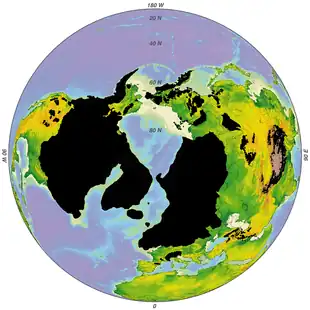Events of the Tonian Period | ||||||||||
−1000 — – −980 — – −960 — – −940 — – −920 — – −900 — – −880 — – −860 — – −840 — – −820 — – −800 — – −780 — – −760 — – −740 — – −720 — – |
| |||||||||
The Kaigas glaciation was a hypothesized snowball earth event in the Neoproterozoic Era, preceding the Sturtian glaciation. Its occurrence was inferred based on the interpretation of Kaigas Formation conglomerates in the stratigraphy overlying the Kalahari Craton as correlative with pre-Sturtian Numees formation glacial diamictites. However, the Kaigas formation was later determined to be non-glacial, and a Sturtian age was assigned to the Numees diamictites. Thus, there is no longer any evidence for a Neoproterozoic glaciation prior to the Sturtian snowball earth event.[3]
References
- ↑ Brain, C. K.; Prave, A. R.; Hoffmann, K. H.; Fallik, A. E.; Herd D. A.; Sturrock, C.; Young, I.; Condon, D. J.; Allison, S. G. (2012). "The first animals: ca. 760-million-year-old sponge-like fossils from Namibia". S. Afr. J. Sci. 108 (8): 1–8. doi:10.4102/sajs.v108i1/2.658.
- ↑ Bernhard, Joan (11 June 2013). "Insights into foraminiferal influences on microfabrics of microbialites at Highborne Cay, Bahamas". Proceedings of the National Academy of Sciences of the United States of America. 110 (24): 9830–9834. Bibcode:2013PNAS..110.9830B. doi:10.1073/pnas.1221721110. PMC 3683713. PMID 23716649.
- ↑ Rooney, A. D.; Strauss, J. V.; Brandon, A. D.; MacDonald, F. A. (2015). "A Cryogenian chronology: Two long-lasting synchronous Neoproterozoic glaciations". Geology. 43 (5): 459. Bibcode:2015Geo....43..459R. doi:10.1130/G36511.1.
This article is issued from Wikipedia. The text is licensed under Creative Commons - Attribution - Sharealike. Additional terms may apply for the media files.
